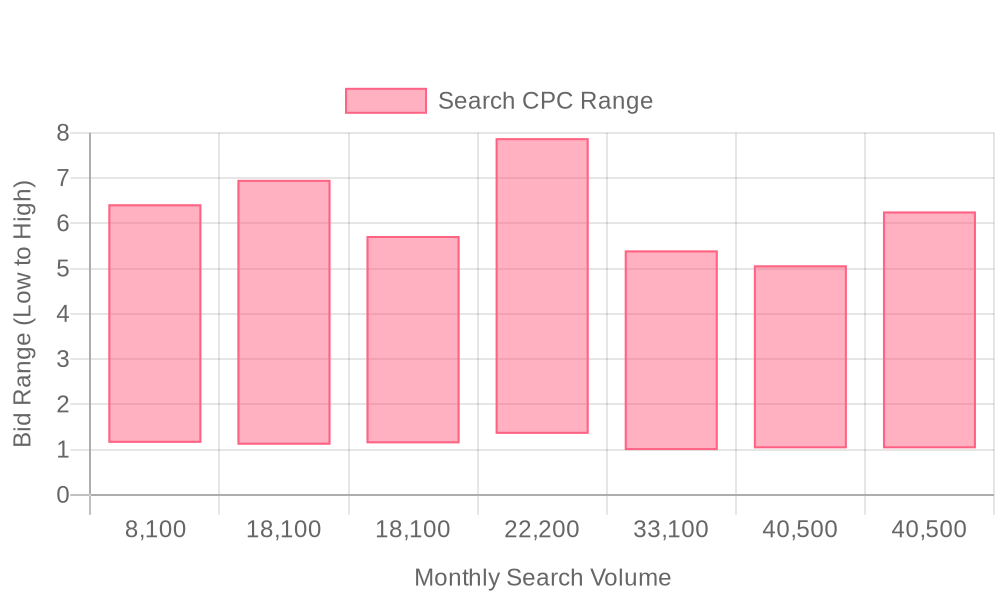
Supercharge your lead generation with a FREE Google Ads audit - no strings attached! See how you can generate more and higher quality leads
Get My Free Google Ads AuditFree consultation

No commitment
Supercharge your lead generation with a FREE LinkedIn Ads audit - no strings attached! See how you can generate more and higher quality leads
Get My Free Google Ads AuditFree consultation

No commitment
Supercharge your lead generation with a FREE Meta Ads audit - no strings attached! See how you can generate more and higher quality leads
Get My Free Google Ads AuditGet My Free LinkedIn Ads AuditGet My Free Meta Ads AuditFree consultation

No commitment
Supercharge your lead generation with a FREE Google Ads audit - no strings attached! See how you can generate more and higher quality leads
Get My Free Google Ads AuditFree consultation

No commitment
The EMT training program landscape is becoming increasingly competitive, making it essential for institutions to leverage effective digital marketing strategies. Many training providers face the challenge of high-value prospects slipping through the cracks because they aren't effectively tracked. Google Ads offers a powerful platform to connect with potential students right when they're searching for EMT training solutions, but without insightful strategies, these leads might remain untapped. By integrating predictive models and real-time data analytics, institutions can optimize campaigns to attract and convert high-intent prospects while aligning with broader marketing goals.

Modern EMT training programs require more than traditional outreach to fill seats with qualified, engaged students. Digital marketing for EMT programs, especially through Google Ads, delivers precision targeting, scalable reach, and real-time feedback that drive measurable enrollment results.
With the right strategy, you can zero in on prospective students actively searching for EMT certification promotion or online EMT training ads. By leveraging advanced targeting and analytics, these campaigns ensure your advertising budget works harder, attracting high-intent audiences and accelerating the path to application. Lead Generation with Google Ads provides a deeper look at this trend.

Google Ads for EMT training programs delivers immediate access to high-intent prospects who are actively searching for certification, reducing lag compared to traditional outreach methods. By capturing these motivated individuals at the precise moment of their interest, EMT programs can fill classes faster and minimize wasted ad spend.
The platform’s precise conversion tracking supports measurable ROI, connecting ad clicks directly to program enrollments and enabling revenue teams to optimize campaigns based on real outcomes. When CRM data is unified with Google Ads, marketers can attribute every qualified lead or registration to its originating campaign, gaining full-funnel clarity and eliminating guesswork. Conversion tracking provides a technical overview of how this works in practice.
Advanced audience targeting elevates digital marketing for EMT programs by segmenting campaigns for healthcare professionals, students, and career switchers. Predictive audience models, refreshed in real time as leads engage or convert, ensure ad budgets focus only on the most promising prospects. This builds on strategies outlined in retargeting campaigns, which explores high-impact campaign optimization.
Google Ads strategies for education also amplify messaging by syncing campaign audiences and creative across channels such as social media and email. Consistency in brand voice and offer details across every touchpoint fosters trust, while cross-channel data flows allow marketers to refine their outreach with each interaction. This synergy ultimately drives higher conversion rates and maximizes enrollment growth for EMT certification promotion.

Google Ads for EMT training programs allows organizations to reach prospects with precision, leveraging data-driven insights to prioritize high-converting audiences. With unified go-to-market data, revenue teams can pinpoint which ad placements and creative variations drive the most qualified leads, optimizing spend for maximum enrollment impact. One analysis in Emulent PPC Strategy explores how technical schools can maximize PPC effectiveness through audience segmentation.
Ready to take your EMT program’s Google Ads campaigns to the next level? Get started now to see how smarter targeting can drive more qualified enrollments.
EMT training programs operate in a highly competitive digital landscape where identifying growth opportunities requires precision and agility. Success hinges on uncovering high-intent prospects and reaching them with relevant messaging at the optimal moment.
Ready to uncover more growth opportunities? Get started now.

Precise audience segmentation allows EMT training programs to minimize wasted spend and maximize engagement with relevant prospects. By distinguishing between groups such as high school graduates considering a healthcare career and practicing professionals seeking recertification, marketers deliver targeted outreach that resonates with each segment’s priorities.

| Industry | Keyword | Monthly Search Volume | Competition Level | Low Bid | High Bid |
| EMT Training Programs | emt training programs | 8100 | LOW | 1.15 | 6.42 |
| EMT Training Programs | emt school | 18100 | LOW | 1.11 | 6.96 |
| EMT Training Programs | emt classes | 18100 | LOW | 1.14 | 5.72 |
| EMT Training Programs | paramedic school | 22200 | LOW | 1.35 | 7.88 |
| EMT Training Programs | emt training | 33100 | LOW | 0.99 | 5.4 |
| EMT Training Programs | emt certification | 40500 | LOW | 1.03 | 5.07 |
| EMT Training Programs | emt classes near me | 40500 | LOW | 1.03 | 6.26 |
A focused keyword strategy is the foundation of high-performing google ads for EMT training programs. Start with high-intent keywords like "EMT training program advertising," "EMT certification promotion," and "online EMT training ads" to capture users actively searching for education and certification pathways. Incorporating keyword variations tied to specific program offerings, such as "accelerated EMT courses" or "hybrid paramedic classes," helps ensure your ads are positioned for the most relevant, high-probability leads.
Adding local modifiers like "EMT courses near me" or "emergency medical technician training in [city]" maximizes geographic relevance. Predictive location analysis lets marketers prioritize spend in high-conversion regions, while dynamic audience segmentation keeps ads visible to prospects with the strongest enrollment intent. Solutions such as Sona ID Tools support pinpointing individual prospects and organizations for more granular keyword refinement and budget allocation.
Consistently guiding content and ad copy through keyword opportunities discovered within Google Ads ensures campaigns remain focused on the terms most likely to convert. Google Ads Best Practices provides actionable guidance for campaign optimization. Negative keywords play a crucial role in filtering out irrelevant or low-intent search queries, such as "EMT job descriptions" or "free EMT resources," so every dollar targets quality traffic. As leads progress through the funnel, dynamic audience updates and real-time intent signals further optimize targeting, ensuring your keyword strategy adapts to shifting market demand and drives measurable enrollment growth.
A well-structured keyword strategy is foundational for driving high-quality leads in EMT training program advertising. Focus on course-specific, certification-related, and long-tail keywords that reflect prospective students’ intent: examples include “EMT certification near me,” “accelerated paramedic training,” and “online EMT classes with certification.” These variations capture a range of buyers, from those seeking foundational courses to those pursuing advanced credentials. Incorporate geotargeted phrases to align with local search demand, ensuring your ads surface for candidates ready to enroll in nearby programs.
With advanced visitor identification, marketers can move beyond anonymous web traffic to pinpoint the companies and individuals most likely to convert. Tools like Sona Identification help uncover high-intent visitor segments, enabling more precise keyword targeting and campaign efficiency.
As users search for specific course attributes or schedule preferences, your campaigns automatically surface relevant ads, maximizing both reach and efficiency for Google Ads targeting for training programs. For further details on optimizing keyword strategies in technical education, see the Emulent playbook for actionable PPC tactics.
Conversion-focused ad copy is critical to stand out in the competitive landscape of Google Ads for EMT training. Highlight urgent enrollment windows, financial aid availability, and trust markers such as national accreditation or high pass rates. Use concise CTAs like “Apply for Spring Cohort” or “Reserve Your Spot” to prompt immediate action. Reinforcing program credibility in headlines and descriptions instills confidence, especially among career-focused prospects evaluating multiple options.
Leverage CRM data to segment audiences and tailor messaging to in-market users who have previously engaged with your site or expressed interest in specific course modalities. Platforms like Sona Audiences automate ad personalization and audience segmentation for higher campaign relevance.
By syncing enriched lead and audience data directly into your ad platform, you can automate ad personalization and ensure your campaigns speak directly to the needs and concerns of each segment. This approach drives meaningful engagement and increases the likelihood of qualified conversions.
Landing pages should deliver a seamless experience that matches the promise of your ads and supports the EMT certification promotion journey. Focus page content on benefits such as flexible class schedules, job placement statistics, and clear next steps. Use persuasive design elements: prominent enrollment forms, eligibility checklists, and testimonials from recent graduates. Remove distractions and prioritize a single, compelling call-to-action to guide visitors toward enrollment or information requests.
With dynamic audience data, landing pages can adapt content based on user segment or prior engagement. For example, returning visitors may see fast-track enrollment options, while first-time users are presented with detailed program overviews. See high-converting CTAs for landing pages.
Integrated conversion tracking links online form fills and offline calls to advertising spend, enabling accurate attribution and ongoing optimization of your digital marketing for EMT programs.
Continuous campaign improvement is essential for maximizing ROI and minimizing wasted spend in Google Ads strategies for education. Deploy A/B testing frameworks to refine ad messaging, landing page layouts, and conversion paths. Use smart bidding strategies that respond to signals such as device, time of day, and user location to prioritize budget toward the highest-value actions. For more insights on measuring and attributing campaign revenue, check out our revenue attribution guide.
Advanced conversion tracking enables you to measure both online and offline interactions, attributing enrollment or consultation requests back to the original ad and keyword. As audience segments evolve through the funnel, dynamic syncing ensures your campaigns automatically adjust to target those most likely to convert. See Google Ads benchmarks for conversion tracking and optimization best practices.
This unified approach provides revenue teams with actionable insight, supporting data-backed decisions for advertising EMT courses and driving sustainable growth.

Digital-first marketing allows EMT training programs to reach prospective students where they actively research education options. Building a unified presence across platforms ensures that your brand stays top-of-mind during the decision-making process.
Mastering Google Ads for your EMT training program isn’t just about reaching more eyes—it’s about connecting with the right students who are eager to launch their careers in healthcare.
By now, you’ve seen how strategic keyword targeting, compelling ad copy, and precise audience segmentation can transform your campaigns from generic to high-converting. Whether you’re competing for local trainees or expanding nationally, these tactics ensure your program stands out in a crowded market.
Imagine filling your classes with motivated students who are ready to enroll—no more wasted ad spend or missed opportunities. With the right approach, your EMT training program can become the go-to choice for aspiring healthcare professionals.
Ready to put these strategies into action? Start a free trial to experience Sona's platform and its capabilities.
Best practices include defining clear lead generation and enrollment objectives, selecting targeted keywords, crafting compelling ad copy, designing optimized landing pages, implementing conversion tracking, enhancing targeting and segmentation, and continuously testing and refining campaigns.
You can effectively target students by using advanced targeting and analytics to focus on high-intent audiences, leveraging predictive models and real-time data, and refining your audience segments based on their readiness to enroll.
Use keywords such as 'EMT training near me,' 'accelerated EMT certification,' and 'EMT courses online,' along with local modifiers to capture high-intent prospects actively searching for EMT training programs.
The article does not specify the exact cost but emphasizes optimizing spend by targeting high-converting audiences and using data-driven insights to prioritize budget allocation for maximum enrollment impact.
Success can be measured through conversion tracking, which involves tracking valuable actions like form fills and phone calls, and attributing enrollments to specific ads and keywords to optimize campaigns based on real outcomes.
Join results-focused teams combining Sona Platform automation with advanced Google Ads strategies to scale lead generation

Connect your existing CRM

Free Account Enrichment

No setup fees
No commitment required

Free consultation

Get a custom Google Ads roadmap for your business
Join results-focused teams combining Sona Platform automation with advanced Meta Ads strategies to scale lead generation

Connect your existing CRM

Free Account Enrichment

No setup fees
No commitment required

Free consultation

Get a custom Google Ads roadmap for your business
Join results-focused teams combining Sona Platform automation with advanced LinkedIn Ads strategies to scale lead generation

Connect your existing CRM

Free Account Enrichment

No setup fees
No commitment required

Free consultation

Get a custom Google Ads roadmap for your business
Join results-focused teams using Sona Platform automation to activate unified sales and marketing data, maximize ROI on marketing investments, and drive measurable growth

Connect your existing CRM

Free Account Enrichment

No setup fees
No commitment required

Free consultation

Get a custom Google Ads roadmap for your business
Over 500+ auto detailing businesses trust our platform to grow their revenue
Join results-focused teams using Sona Platform automation to activate unified sales and marketing data, maximize ROI on marketing investments, and drive measurable growth

Connect your existing CRM

Free Account Enrichment

No setup fees
No commitment required

Free consultation

Get a custom Google Ads roadmap for your business
Over 500+ auto detailing businesses trust our platform to grow their revenue
Join results-focused teams using Sona Platform automation to activate unified sales and marketing data, maximize ROI on marketing investments, and drive measurable growth

Connect your existing CRM

Free Account Enrichment

No setup fees
No commitment required

Free consultation

Get a custom Google Ads roadmap for your business
Over 500+ auto detailing businesses trust our platform to grow their revenue
Our team of experts can implement your Google Ads campaigns, then show you how Sona helps you manage exceptional campaign performance and sales.
Schedule your FREE 15-minute strategy sessionOur team of experts can implement your Meta Ads campaigns, then show you how Sona helps you manage exceptional campaign performance and sales.
Schedule your FREE 15-minute strategy sessionOur team of experts can implement your LinkedIn Ads campaigns, then show you how Sona helps you manage exceptional campaign performance and sales.
Schedule your FREE 15-minute strategy sessionOur team of experts can help improve your demand generation strategy, and can show you how advanced attribution and data activation can help you realize more opportunities and improve sales performance.
Schedule your FREE 30-minute strategy sessionOur team of experts can help improve your demand generation strategy, and can show you how advanced attribution and data activation can help you realize more opportunities and improve sales performance.
Schedule your FREE 30-minute strategy sessionOur team of experts can help improve your demand generation strategy, and can show you how advanced attribution and data activation can help you realize more opportunities and improve sales performance.
Schedule your FREE 30-minute strategy sessionOur team of experts can help improve your demand generation strategy, and can show you how advanced attribution and data activation can help you realize more opportunities and improve sales performance.
Schedule your FREE 30-minute strategy session





Launch campaigns that generate qualified leads in 30 days or less.
